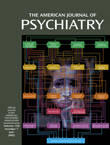Hippocampal Changes in Patients With a First Episode of Major Depression
Abstract
OBJECTIVE: Previous work suggests that patients with unipolar depression may have structural as well as functional abnormalities in limbic-thalamic-cortical networks, which are hypothesized to modulate human mood states. A core area in these networks is the hippocampus. In the present study, differences in volumes of hippocampal gray and white matter between patients with a first episode of major depression and healthy comparison subjects were examined. METHOD: Thirty patients with a first episode of major depression and 30 healthy comparison subjects who were matched for age, gender, handedness, and education were examined with high-resolution magnetic resonance imaging. RESULTS: Male patients with a first episode of major depression had significantly smaller hippocampal total and gray matter volumes than healthy male comparison subjects. Both male and female patients showed significant alterations of left-right asymmetry and significant reductions of left and right hippocampal white matter fibers in relation to healthy comparison subjects. Hippocampal measurements were not significantly correlated with clinical variables, such as age at onset of illness, illness duration, or severity of depression. CONCLUSIONS: These results are consistent with findings of structural abnormalities of the hippocampal formation in patients with major depression that were more pronounced in male patients. The authors’ findings support the hypothesis that the hippocampus and its connections within limbic-cortical networks may play a crucial role in the pathogenesis of major depression.



